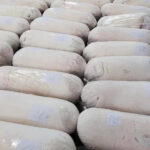The potential export item is footwear. According to the General Department of Customs, the export value of Vietnam’s footwear in December reached over $1.8 billion, a 3.6% decrease compared to November. In 2023, the total export turnover of Vietnam’s footwear industry is expected to reach over $20.2 billion, a 15.3% decrease compared to 2022.
Vietnam currently ranks 2nd globally (after China) in footwear exports, accounting for an estimated 10% of the world’s market share. According to the World Footwear Yearbook, Vietnam became the largest exporter of textile shoes in the world in terms of value in 2020, surpassing China.
In fact, Vietnam’s footwear is exported to more than 150 countries worldwide, including major markets such as the US, EU, and China.

In 2023, Vietnam’s footwear exports exceeded $20 billion. Illustrative photo
Special mention should be made of the three largest import markets for Vietnam’s footwear in 2023: the US (over $7.1 billion, a 25.5% decrease compared to 2022), China (1.8 billion USD, an increase of 9.3% compared to 2022), and Belgium (over $1.2 billion, a 26% decrease compared to the previous year).
According to experts, 2023 is a challenging year for Vietnam’s footwear industry due to a decrease in production and export turnover. The reason is the inflationary situation that has led to a decrease in consumer spending in major markets such as the US, EU, and Japan, resulting in a large inventory of products.
Despite the difficulties, footwear is still Vietnam’s key export sector due to its high-quality products and strong competitiveness in the global market. This industry is still expected to recover and develop in the future. By 2030, the target of Vietnam’s leather and footwear industry is to achieve a total export turnover of footwear and bags from $38 to $40 billion.
The footwear industry adapts to new requirements

Vietnam is the world’s second-largest footwear exporter, but it still has to import a lot of raw materials. Photo: AI
Although it is the key export industry, the distribution activities of Vietnamese footwear companies are still underdeveloped and dependent on foreign buyers. In fact, Vietnamese footwear companies still have to go through regional suppliers to secure manufacturing contracts. Some footwear companies even have to go through the representative offices of famous brands in Vietnam to provide products.
On the other hand, despite many advantages, Vietnam’s leather footwear industry has not fully exploited its potential because raw materials for production are mainly imported from other countries.
According to data from the General Department of Customs, in just the first 11 months of 2023, Vietnamese textile, garment, and leather footwear companies spent $21.94 billion on importing raw materials from other countries. Among them, the group of raw materials serving this industry is mainly imported from China, with a cost of $11.62 billion, accounting for 53%.
The reason why Vietnam’s footwear industry has to spend billions of dollars on imports is that the domestic leather raw material supply can only meet 10% of the industry’s demand. In addition, technically demanding materials such as soles and linings are hardly produced domestically.
According to experts, to maintain its position as the leading exporter in the international market, Vietnam’s leather and footwear industry needs to build and develop a supply chain. The industry also needs to invest selectively in products with strengths to enhance capabilities, cooperation, and better exploitation of equipment.
References: Customs, MOIT, Gotsneakers












